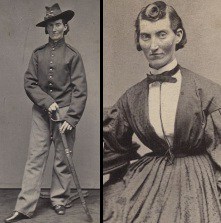Frankly My Dear….Put on Your Bloomers and Get to Work
[image error]Speaking of change…(which I do often), a couple times a month I work at an adventure clothing store. Mostly I chitter-chat, and listen to others’ tales. It’s a writer’s haven for character studies.
But every now and then, there are days that I’d rather be in the sunshine than caged in a store. In other words. I don’t want to work that day. Last Tuesday as I trudged and groused to work, I passed a poster of Rosie the Riveter and blamed her. After all, it was the stalwart women of WWII who changed the workforce of America.
EXCEPT…THEY WEREN’T THE FIRST
What??? This is like discovering the earth isn’t flat, or objects aren’t made out of particles. (They’re made out of wave packets).

Frances Clayton fought as Frances Clalin (Library of Congress)
Well…it turns out … it was the women of the Civil War who were the first adapters of getting off the ol’ plantation and into the workforce. Because both North and the South thought the skirmish would end quickly, men signed up in droves. If they didn’t, young ladies in Texas handed out hoopskirts and bonnets to men who didn’t enlist.
And women did their duty, too. It’s estimated that around 400 women disguised themselves and signed up to fight. Some enlisted so they could stay with their husbands. Others worked as spies and nurses.
That left the rest of the women to keep the farm/plantation and home fires running.
AND THEN REALITY SET IN
[image error]
Arlington by Mike Boswell
Homes were shelled. Farms and foods were taken over by the military. Over 200,000 women and children were forced to move as the Union worked their way south. The early Rah-Rah-Rah of patriotism stuttered to a halt. Attitudes CHANGED! Many Southern women now felt the war was a betrayal by the men who’d left them.
Eventually, these gals did what steel magnolia do…went to work. Goodbye hoopskirts and fancy hair. (Because there were no slaves to yank corsets tight and pin up tresses.)
Hello …
Wearing Bloomers
Wearing Shorter hair
Doing Field work (plowing, planting, milking, cooking)
Running what was left of the company business (if there was one) (Go get ‘em Scarlett!)
Working in Government clerical jobs.
Doing piecework for the Confederate Clothing Bureau (Shirts $1 each, Coats $4)
Packing cartridges at the arsenal ($1 a day)
And their misery didn’t end with Robert E. Lee’s surrender. A quarter of the men had been killed, a quarter had been wounded and broken.
ATTITUDES CHANGED AGAIN
Now cultural pressures urged Southern women to do their duty by marrying veterans, especially a man who had a missing arm or amputated leg.
North or South, many women found they must now work. Their way of life in which someone took care of them was broken.
THE WORLD HAD CHANGED.
[image error]
And if you don’t have the chicken fried and the ironin’ done by the time I get home from work, Rhett, I’m breaking every bottle of your boot-legged beer.
So next time you’re grousing about work, thank the fictional Scarlett O’Hara for putting on her big-girl bloomers and doing what needed to be done.
(That’s what women have been doing for centuries.)
Resources: America’s Women: 400 Years of Dolls, Drudges, Helpmates, and Heroines by Gail Collins.











